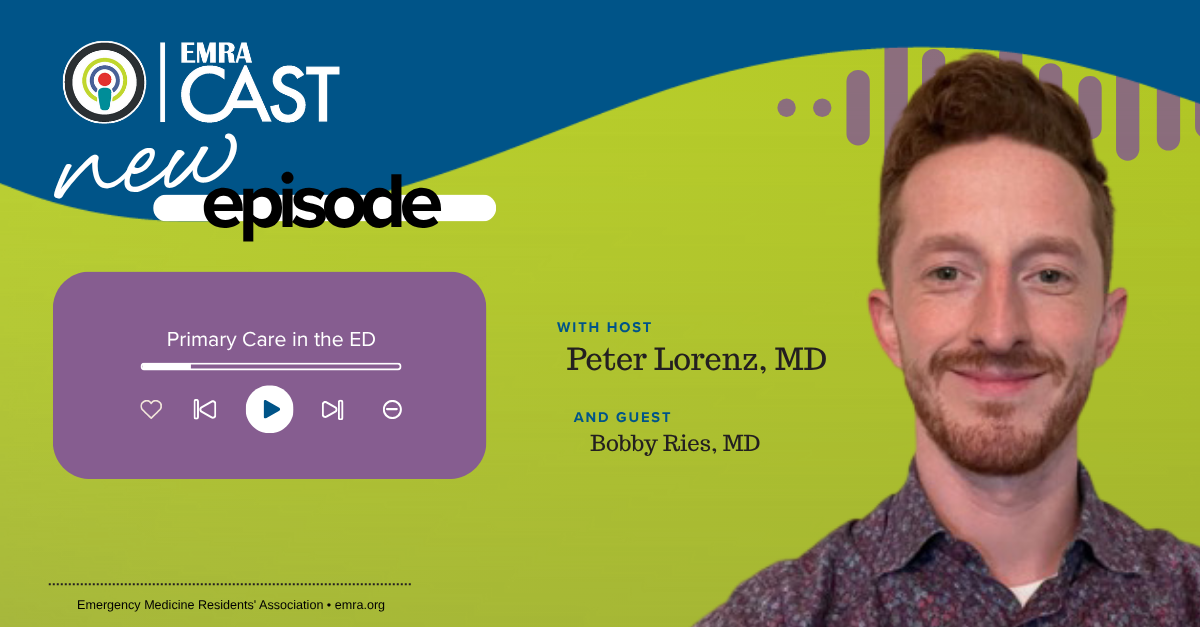Primary Care in the ED
Primary Care in the ED
Oct. 1, 2025
The emergency department offers critical access to health care in our broken system. An important skillset of the modern emergency physician is a set of low-risk, low-time commitment, high-benefit interventions for the management of chronic diseases. In this episode, Peter Lorenz, MD, and guest Bobby Ries, MD, discuss the diagnosis and management of hypertension, type 2 diabetes, asthma, alcohol use disorder, and tobacco use disorder from the emergency department.
Host
Peter Lorenz, MD
Christiana Care
EM/IM Combined Residency Class of 2027
EMRA*Cast Episodes
Guest
Bobby Ries, MD
EM/FM Resident, ChristianaCare
As an Emergency Medicine / Family Medicine combined resident at Christiana, Bobby enjoys higher acuity clinical scenarios but also appreciates time to connect with patients on a long-term basis. In his free time, he loves to send it for hiking and snowboarding adventures. Like other Christiana residents, Bobby rescued one of the many Wilmington stray cats and is now father to a goofy orange cat named Dewey.
OVERVIEW
The emergency department offers critical access to health care in our broken system. An important skillset of the modern emergency medicine physician is a set of low-risk, low-time commitment, high-benefit interventions for the management of chronic diseases. In this episode, we discuss the diagnosis and management of hypertension, type 2 diabetes, asthma, alcohol use disorder, and tobacco use disorder from the emergency department.
Discussion
Is it a part of your practice to initiate or modify treatments for chronic conditions from the emergency department?
- The patient population discussed comprises “outpatients” who are:
- Stable for discharge
- Issue is chronic
- While evidence-based, interventions are our opinion only.
- All patients need to be referred to primary care!
HYPERTENSION
Diagnosis in clinic
- 2 ideal time separated measurements, multiple home measurements, ambulatory monitoring
- Stage 1: 130-139/80-89
- Stage 2: >140/>90
Diagnosis in the ED
- No clear consensus, 160/100? 180/110?
- Look for trends in previous documentation
- Ensure pain or other stressors are managed first
Medication of choice: Amlodipine 5-10 mg PO once daily
- No laboratory monitoring
- 5-10 mmHg drop in SBP
- Side effects: constipation, ankle edema
Lifestyle changes
- Weight loss, reduce salt, increase potassium, DASH diet, physical activity
- Discontinuation of chronic NSAIDs
Evidence/support
- AHA, ACEP guidelines support initiation from ED
Future consideration
- Guidelines also support titration of medications if BP is undertreated
TYPE 2 DIABETES
Diagnosis in clinic
- A1c > 6.5, fasting Glc > 126, 2 hr 75 g glucose tolerance test >200, classic signs or symptoms of hyperglycemia with glucose >200
Diagnosis in the ED
- Glucose >200 without PO intake in 2 hrs
- Glucose >200 with signs or symptoms of hyperglycemia such as polyuria, polydipsia, blurry vision, etc.
- Ensure not on steroids or experiencing significant physiologic stress
- Exclude Type I Diabetes
- UA: Look for ketones
- Weight loss is concerning for type I diabetes/insulin deficiency
- ADA; AABBCC approach
- AA: Age <35, Autoimmunity (personal or family)
- BB: BMI <25, Background: FHx T1DM
- CC: Control: inability to achieve glycemic control on non-insulin therapy, Comorbidities: Checkpoint inhibitors can cause new-onset T1DM in older adults
Medication of choice: metformin
- Prescription: 500 mg tablet of metformin ER, 2 tablets 2 times per day
- Instructions: Start at 1 tablet once per day, once GI symptoms resolve increase to 1 tablet twice per day, once GI symptoms resolve continue increasing to a maximum of 2 tablets twice per day
- Side effects
- Diarrhea
- Metformin-associated lactic acidosis
- Life threatening
- Occurs typically in setting of AKI on CKD
- Contraindication: GFR <30
Lifestyle interventions
- Discontinue sugary beverages!
- Weight loss and Mediterranean diet
- Physical activity
Future considerations
- POC A1c machine in your ED
- Protocol, in collaboration with OP offices, diabetes educators, for initiating insulin from the ED (have been well-described)
ALCOHOL USE DISORDER
Diagnosis in clinic
- DSM 5 Criteria
Diagnosis in the ED
- Gestalt typically sufficient
Medication of choice: Naltrexone 50 mg daily
- NNT 12
- Tends to be more effective in reducing binge drinking
- Can be transitioned to long acting injectable
- Side effects: fatigue, nausea
- Contraindications
- Opioid use
- Advanced/decompensated liver disease (Child Pugh C)or transaminases 3x ULN
- Can consider acamprosate in these patients. Contraindication to acamprosate is CKD
Guideline support
- GRACE-4 guidelines from SAEM
Future considerations
- Develop familiarity with acamprosate as well
- Consider co-prescription of gabapentin which can reduce mild withdrawal symptoms
- LAI naltrexone initiation in the ED has been described
ASTHMA
Diagnosis in clinic
- PFTs and clinical history
Diagnosis in the ED
- Thoughtful consideration
- Up to ⅓ of patients with a clinical diagnosis of asthma do not have asthma
- Despite this, if asthma is the most likely diagnosis, GINA guidelines still recommended ICS containing medication initiation
- Peak flow meter with +20% expiratory flow after bronchodilation is strongly suggestive of asthma
Medication of choice
- ICS + Formoterol
- Symbicort: Budesonide - Formoterol
- Dulera: Mometasone - Formoterol
- Learn your state’s Medicaid formulary
- If symptoms less than 4-5 days or 1 night per week, PRN use, if more frequent, BID + PRN
- SABA only therapy - more ED visits, more asthma progression, higher mortality
- Provide instruction on use
- Without Spacer: https://www.youtube.com/watch?v=Lx_e5nXfi5w
- With Spacer (preferred, especially for kids): https://www.youtube.com/watch?v=BbONuRXJdr0
- Rinse and spit after ICS
Lifestyle interventions
- Smoking cessation
- Trigger identification
Guideline support
- GINA guidelines: After acute care visit for asthma, initiate ICS-Formoterol
Future considerations
- Build familiarity with asthma action plans and peak flow meters
- This can include a prescription for PO steroids for use only if prespecified criteria on asthma action plan are met
TOBACCO USE DISORDER
Diagnosis in clinic and in the ED
- Any tobacco use
Preferred medication: Nicotine replacement therapy, started at highest doses
- Patch: 21 mg
- If trouble sleeping, remove at night, otherwise OK to leave on
- Gum: 4 mg
- Chew then lip like a dip. Can cause stomach upset if chewed too vigorously or swallowed
- Use as soon as cravings begin
- Typically covered by insurance
Lifestyle interventions
- Good evidence for brief negotiated interview from the ED
- Help identify triggers for smoking and identify ways to introduce barriers
- Encourage smoking reduction if cessation is not realistic
- Refer to your state’s quit smoking line
Future considerations
- There is data for varenicline from the inpatient setting, can consider from ED
TAKE-HOME POINTS
- There are low-timecommitment, high-impact pharmacologic and lifestyle interventions for hypertension, type 2 diabetes, alcohol use disorder, asthma, and tobacco use disorder that are feasible from the ED
- These interventions are supported by guidelines and literature
References
- James PA, Oparil S, Carter BL, et al. 2014 evidence-based guideline for the management of high blood pressure in adults: report from the panel members appointed to the Eighth Joint National Committee (JNC 8). JAMA. 2014;311(5):507-20.
- Bress AP, Anderson TS, Flack JM, et al, for the American Heart Association Council on Hypertension; Council on Cardiovascular and Stroke Nursing; and Council on Clinical Cardiology. The Management of Elevated Blood Pressure in the Acute Care Setting: A Scientific Statement From the American Heart Association. Hypertension. 2024;81(8):e94-e106.
- Gemme S, Meltzer AC, Byyny R, et al, for the American College of Emergency Physicians Clinical Policies Subcommittee (Writing Committee) on Asymptomatic Hypertension. Clinical Policy: A Critical Issue in the Outpatient Management of Adult Patients Presenting to the Emergency Department with Asymptomatic Elevated Blood Pressure. Ann Emerg Med. 2025;86(1):e1-e11.
- Brody A, Rahman T, Reed B, Millis S, Ference B, Flack JM, Levy PD. Safety and efficacy of antihypertensive prescription at emergency department discharge. Acad Emerg Med. 2015;22(5):632-635.
- Todd BR, Xing Y, Zhao L, Nguyen A, Swor R, Eberhardt L, Bahl A. Antihypertensive prescription is associated with improved 30-day outcomes for discharged hypertensive emergency department patients. J Am Coll Emerg Physicians Open. 2024;5(2):e13138.
- Whelton PK, Carey RM, Aronow WS, et al. 2017 ACC/AHA/AAPA/ABC/ACPM/AGS/APhA/ASH/ASPC/NMA/PCNA Guideline for the Prevention, Detection, Evaluation, and Management of High Blood Pressure in Adults: A Report of the American College of Cardiology/American Heart Association Task Force on Clinical Practice Guidelines. J Am Coll Cardiol. 2018;71(19):e127-e248. Erratum in: J Am Coll Cardiol. 2018;71(19):2275-2279.
- American Diabetes Association Professional Practice Committee. Diagnosis and Classification of Diabetes: Standards of Care in Diabetes—2024. Diabetes Care. 2024; 47 (Supplement_1): S20–S42.
- American Diabetes Association Professional Practice Committee. Pharmacologic Approaches to Glycemic Treatment: Standards of Care in Diabetes—2025. Diabetes Care. 2025; 48 (Supplement_1): S181–S206.
- Magee MF, Nassar CM, Mete M, White K, Youssef GA, Dubin JS. The Synergy to Enable Glycemic Control Following Emergency Department Discharge Program for Adults with Type 2 Diabetes: Step-Diabetes. Endocr Pract. 2015;21(11):1227-39.
- Schwartz X, Porter B, Gilbert MP, Sullivan A, Long B, Lentz S. Emergency Department Management of Uncomplicated Hyperglycemia in Patients without History of Diabetes. J Emerg Med. 2023;65(2):e81-e92.
- Krist AH, Bradley KA. Addressing Alcohol Use. N Engl J Med. 2025;392(17):1721-1731.
- Kranzler HR, Soyka M. Diagnosis and Pharmacotherapy of Alcohol Use Disorder: A Review. JAMA. 2018;320(8):815-824.
- Theodoulou A, Chepkin SC, Ye W, et al. Different doses, durations and modes of delivery of nicotine replacement therapy for smoking cessation. Cochrane Database Syst Rev. 2023;6(6):CD013308.
- Bernstein SL, Dziura J, Weiss J, et al. Successful Optimization of Tobacco Dependence Treatment in the Emergency Department: A Randomized Controlled Trial Using the Multiphase Optimization Strategy. Ann Emerg Med. 2023;81(2):209-221.
- Borgundvaag B, Bellolio F, Miles I, et al. Guidelines for Reasonable and Appropriate Care in the Emergency Department (GRACE-4): Alcohol use disorder and cannabinoid hyperemesis syndrome management in the emergency department. Acad Emerg Med. 2024;31(5):425-455.
- Mohan A, Lugogo NL, Hanania NA, et al. Questions in Mild Asthma: An Official American Thoracic Society Research Statement. Am J Respir Crit Care Med. 2023;207(11):e77-e96.
- Global Initiative for Asthma. Global Strategy for Asthma Management and Prevention, 2025. Updated May 2025. Available from: ginasthma.org.





